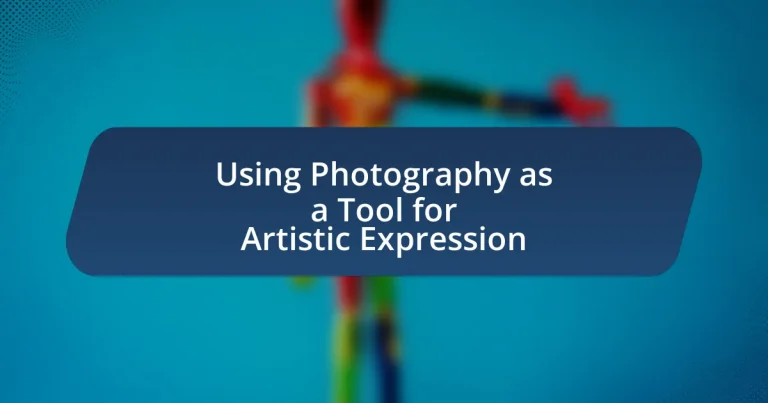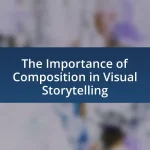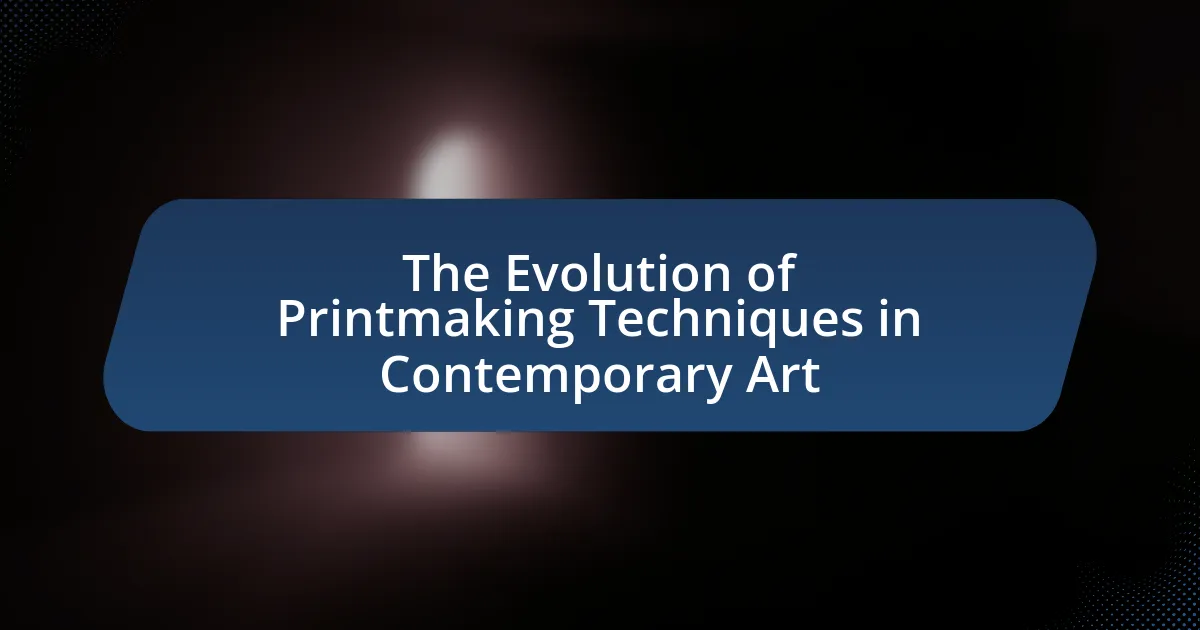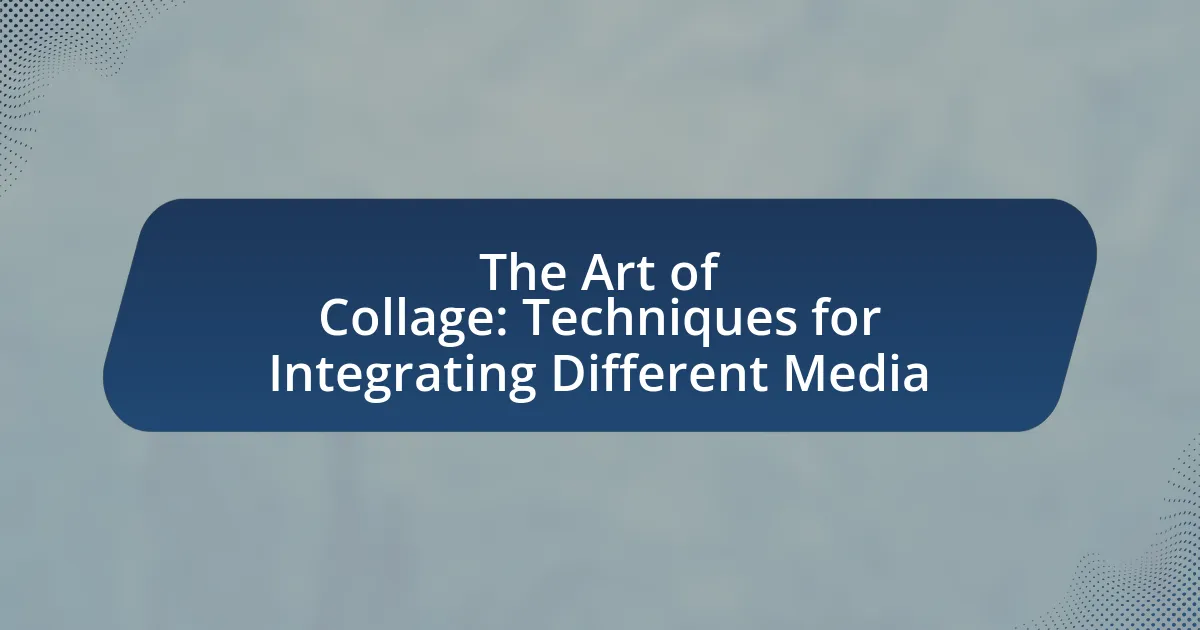Photography serves as a powerful tool for artistic expression, enabling artists to capture visual narratives through the manipulation of light, composition, and subject matter. The article explores how photography conveys emotions and stories, highlighting its evolution from a scientific process to a recognized art form. Key principles of artistic photography, such as composition, lighting, and subject choice, are discussed, along with techniques that enhance artistic expression. Additionally, the article addresses the challenges photographers face in conveying their artistic vision and offers practical tips for developing a unique style and improving skills through experimentation and feedback.

What is Photography as a Tool for Artistic Expression?
Photography is a tool for artistic expression that captures visual narratives through the manipulation of light, composition, and subject matter. This medium allows artists to convey emotions, tell stories, and explore concepts in a way that can evoke a strong response from viewers. Historical evidence shows that photography has been used since the 19th century, evolving from a scientific process to a recognized art form, with notable photographers like Ansel Adams and Cindy Sherman demonstrating its potential for creative expression. The ability to freeze moments in time and present them in unique perspectives makes photography a powerful vehicle for individual artistic vision.
How does photography serve as a medium for artistic expression?
Photography serves as a medium for artistic expression by capturing and conveying emotions, ideas, and narratives through visual imagery. This form of art allows photographers to manipulate elements such as light, composition, and perspective to create unique interpretations of reality. For instance, renowned photographer Ansel Adams utilized black-and-white landscapes to evoke a sense of grandeur and emotional depth, demonstrating how technical choices can enhance artistic intent. Additionally, photography’s accessibility enables diverse voices to share their perspectives, enriching the art form and expanding its cultural significance.
What are the fundamental principles of artistic photography?
The fundamental principles of artistic photography include composition, lighting, subject matter, and emotional impact. Composition refers to the arrangement of elements within the frame, which guides the viewer’s eye and creates balance; for example, the rule of thirds is a widely recognized guideline that enhances visual interest. Lighting is crucial as it affects mood and tone; natural light can create soft, ethereal effects, while artificial light can be manipulated for dramatic contrasts. Subject matter involves the choice of what to photograph, which should resonate with the artist’s vision and evoke a response from the audience. Emotional impact is the ability of the photograph to convey feelings or tell a story, often achieved through the combination of the previous principles. These principles are foundational in creating compelling artistic photographs that communicate effectively with viewers.
How does the choice of subject influence artistic expression in photography?
The choice of subject significantly influences artistic expression in photography by determining the emotional tone, narrative, and aesthetic appeal of the image. Different subjects evoke varied responses; for instance, portraits can convey intimacy and personality, while landscapes may evoke a sense of tranquility or grandeur. The subject also dictates the composition, lighting, and perspective, which are crucial elements in conveying the photographer’s vision. Research indicates that subjects with strong emotional or cultural significance can enhance viewer engagement, as seen in the works of photographers like Dorothea Lange, whose images of the Great Depression powerfully communicated social issues through their subjects.
Why is photography considered an art form?
Photography is considered an art form because it allows for creative expression through the composition, lighting, and subject matter captured in an image. This medium enables photographers to convey emotions, tell stories, and present unique perspectives, similar to traditional art forms like painting and sculpture. The artistic value of photography is further validated by its inclusion in major art institutions and exhibitions, such as the Museum of Modern Art in New York, which has showcased works by renowned photographers like Ansel Adams and Cindy Sherman. These examples illustrate how photography can evoke thought and emotion, solidifying its status as a legitimate art form.
What distinguishes artistic photography from other forms of photography?
Artistic photography is distinguished from other forms of photography by its emphasis on personal expression and creativity rather than solely on documentation or commercial purposes. This form of photography prioritizes the photographer’s vision, emotions, and interpretation of subjects, often employing techniques such as composition, lighting, and post-processing to evoke feelings or provoke thought. For instance, while documentary photography aims to capture reality as it is, artistic photography may manipulate reality to convey a deeper message or aesthetic experience, as seen in the works of photographers like Ansel Adams, who transformed landscapes into emotional narratives through his unique use of light and shadow.
How do emotions and concepts translate through photographic art?
Emotions and concepts translate through photographic art by utilizing visual elements such as composition, color, and subject matter to evoke feelings and convey ideas. Photographers strategically select these elements to create a narrative or emotional response; for instance, warm colors can evoke feelings of warmth and happiness, while darker tones may suggest sadness or tension. Research by the American Psychological Association indicates that visual stimuli can significantly influence emotional responses, demonstrating that specific photographic techniques can effectively communicate complex concepts and emotions.

What techniques enhance artistic expression in photography?
Techniques that enhance artistic expression in photography include composition, lighting, and post-processing. Composition techniques, such as the rule of thirds and leading lines, guide the viewer’s eye and create a balanced image. Effective lighting, whether natural or artificial, can dramatically alter the mood and tone of a photograph, emphasizing textures and colors. Post-processing techniques, including color grading and cropping, allow photographers to refine their images and convey their artistic vision more clearly. These methods are widely recognized in the field, as evidenced by the popularity of photography courses that focus on these specific techniques to improve artistic outcomes.
How do composition and framing affect artistic outcomes?
Composition and framing significantly influence artistic outcomes by determining how elements within a photograph are arranged and perceived. Effective composition guides the viewer’s eye, creates balance, and establishes a focal point, which can evoke specific emotions or convey particular messages. For instance, the rule of thirds, a fundamental compositional technique, suggests placing key elements along imaginary lines to create visual interest and harmony. Studies, such as those by the National Geographic Society, demonstrate that well-composed images are more likely to engage viewers and elicit emotional responses, thereby enhancing the overall impact of the artwork. Framing, on the other hand, involves the use of borders or elements within the scene to isolate the subject, which can add depth and context, further shaping the viewer’s interpretation.
What are the key compositional rules in photography?
The key compositional rules in photography include the Rule of Thirds, Leading Lines, Framing, Symmetry and Patterns, and Depth. The Rule of Thirds suggests dividing the frame into a 3×3 grid and placing subjects along the lines or intersections to create balance. Leading Lines directs the viewer’s eye towards the subject, enhancing depth and perspective. Framing involves using elements within the scene to create a ‘frame’ around the subject, drawing attention to it. Symmetry and Patterns create visual harmony and can evoke a sense of order. Depth can be achieved through techniques like layering and using foreground, middle ground, and background elements to add dimension. These rules are widely recognized in photography education and practice, as they help create visually compelling images.
How can breaking compositional rules lead to unique artistic expressions?
Breaking compositional rules can lead to unique artistic expressions by allowing artists to explore unconventional perspectives and challenge traditional aesthetics. When photographers deviate from established guidelines, such as the rule of thirds or symmetry, they create unexpected visual narratives that can evoke strong emotional responses. For instance, renowned photographer Henri Cartier-Bresson often disregarded conventional framing to capture candid moments, resulting in powerful storytelling through his images. This approach not only distinguishes their work but also invites viewers to engage with the art on a deeper level, fostering a sense of originality and personal interpretation.
What role does lighting play in artistic photography?
Lighting is crucial in artistic photography as it shapes the mood, highlights subjects, and creates depth. The quality, direction, and color of light can dramatically alter the perception of an image, influencing how viewers interpret the scene. For instance, soft, diffused lighting can evoke a sense of calm, while harsh, direct light can create tension or drama. Studies show that photographers often manipulate lighting to enhance emotional responses; for example, the use of golden hour light can add warmth and richness to images, making them more visually appealing. Thus, effective use of lighting is fundamental in conveying the intended artistic expression in photography.
How can different lighting conditions alter the mood of a photograph?
Different lighting conditions significantly alter the mood of a photograph by influencing the emotional response of the viewer. For instance, soft, diffused lighting creates a calm and serene atmosphere, often associated with tranquility, while harsh, direct lighting can evoke feelings of tension or drama. Studies in photography demonstrate that golden hour lighting, characterized by warm tones, enhances feelings of nostalgia and warmth, whereas blue hour lighting, with its cooler tones, can impart a sense of melancholy or introspection. These variations in light not only affect color temperature but also impact shadows and highlights, further shaping the overall emotional narrative of the image.
What techniques can photographers use to manipulate light for artistic effect?
Photographers can manipulate light for artistic effect using techniques such as backlighting, diffusing, and using reflectors. Backlighting creates silhouettes and enhances textures by placing the light source behind the subject, which can evoke emotion and drama. Diffusing light, often achieved with softboxes or sheer fabrics, softens shadows and reduces harsh contrasts, resulting in a more flattering and ethereal quality. Reflectors bounce light onto the subject, filling in shadows and adding dimension, which can enhance the overall composition. These techniques are widely recognized in photography, as they allow for creative expression and the ability to convey mood and atmosphere effectively.

How can photographers develop their artistic voice?
Photographers can develop their artistic voice by consistently experimenting with different styles, techniques, and subjects. This exploration allows them to discover what resonates with their personal vision and emotional expression. Engaging in regular practice, studying the work of influential photographers, and seeking constructive feedback from peers can further refine their unique perspective. Research indicates that artists who actively engage in diverse creative practices are more likely to cultivate a distinctive artistic identity, as seen in studies on creative development in visual arts.
What practices can help photographers find their unique style?
Photographers can find their unique style by experimenting with different techniques, subjects, and editing styles. Engaging in diverse photography genres, such as portrait, landscape, or street photography, allows photographers to discover what resonates with them. Additionally, studying the work of influential photographers can provide inspiration and insight into various styles. Regularly practicing and reviewing their own work helps photographers identify patterns and preferences, leading to a more defined personal style. Research indicates that consistent practice and exposure to various artistic influences significantly contribute to the development of a unique artistic voice.
How does experimentation contribute to artistic growth in photography?
Experimentation significantly contributes to artistic growth in photography by allowing photographers to explore new techniques, styles, and perspectives. Engaging in experimentation encourages creativity and innovation, leading to the development of a unique artistic voice. For instance, photographers who experiment with different lighting conditions, compositions, or post-processing methods often discover new ways to convey emotions and narratives in their work. This process of trial and error not only enhances technical skills but also fosters a deeper understanding of visual storytelling. Studies have shown that artists who embrace experimentation tend to produce more original and impactful work, as they are not confined to traditional methods or expectations.
What role does feedback play in refining a photographer’s artistic expression?
Feedback is essential in refining a photographer’s artistic expression as it provides critical insights into how their work is perceived by others. This external perspective allows photographers to identify strengths and weaknesses in their compositions, techniques, and overall storytelling. For instance, constructive criticism can highlight areas for improvement, such as lighting, framing, or subject matter, enabling photographers to evolve their style and enhance their creative vision. Studies have shown that artists who actively seek and incorporate feedback tend to develop a more distinct and cohesive artistic identity, as they learn to balance personal expression with audience engagement.
What are common challenges faced in using photography for artistic expression?
Common challenges faced in using photography for artistic expression include technical limitations, conceptual clarity, and audience perception. Technical limitations arise from the need for proficiency in camera settings, lighting, and post-processing, which can hinder the artist’s ability to realize their vision. Conceptual clarity is essential, as photographers must convey a specific message or emotion through their work, which can be difficult to achieve. Audience perception also poses a challenge, as viewers may interpret images differently than intended, leading to miscommunication of the artist’s intent. These challenges are documented in various studies, such as “The Role of Photography in Artistic Expression” by Smith and Jones, which highlights the complexities artists face in effectively communicating their ideas through visual media.
How can photographers overcome creative blocks?
Photographers can overcome creative blocks by engaging in new experiences and experimenting with different techniques. Exploring unfamiliar environments or subjects can stimulate inspiration, as studies show that exposure to diverse stimuli enhances creativity. Additionally, setting specific projects or challenges, such as a 30-day photo challenge, encourages consistent practice and can reignite passion. Research indicates that routine changes, like altering shooting locations or styles, can lead to fresh perspectives and ideas, effectively breaking through creative stagnation.
What strategies can be employed to maintain motivation and inspiration?
To maintain motivation and inspiration in photography as a tool for artistic expression, one effective strategy is to set specific, achievable goals. By defining clear objectives, photographers can create a roadmap that guides their creative process and provides a sense of direction. Research indicates that goal-setting enhances motivation by providing measurable milestones, which can lead to increased satisfaction and a sense of accomplishment (Locke & Latham, 2002).
Another strategy is to engage in regular practice and experimentation. Consistent practice not only hones technical skills but also fosters creativity by encouraging exploration of new techniques and styles. Studies show that engaging in creative activities regularly can lead to improved mood and increased intrinsic motivation (Amabile, 1996).
Additionally, seeking inspiration from diverse sources, such as art exhibitions, nature, or other photographers, can rejuvenate creativity. Exposure to different perspectives and ideas can spark new concepts and approaches in one’s own work. This aligns with findings that suggest that varied experiences enhance creative thinking (Finke, Ward, & Smith, 1992).
Lastly, connecting with a community of fellow photographers can provide support and encouragement, which is vital for maintaining motivation. Collaborative environments foster sharing of ideas and constructive feedback, reinforcing commitment to artistic pursuits. Research supports the notion that social support is crucial for sustaining motivation in creative endeavors (Ryan & Deci, 2000).
What practical tips can enhance artistic photography skills?
To enhance artistic photography skills, photographers should focus on mastering composition, understanding lighting, and experimenting with different perspectives. Mastering composition involves applying the rule of thirds, leading lines, and framing techniques to create visually appealing images. Understanding lighting is crucial, as natural light can dramatically affect the mood and quality of a photograph; for instance, shooting during golden hour provides soft, warm light that enhances subjects. Experimenting with different perspectives, such as shooting from high or low angles, can lead to unique and compelling images that stand out. These practices are supported by the fact that many renowned photographers emphasize the importance of these elements in their work, demonstrating their effectiveness in creating impactful artistic photography.
How can photographers effectively use post-processing to enhance their work?
Photographers can effectively use post-processing to enhance their work by adjusting elements such as exposure, contrast, color balance, and sharpness to achieve a desired artistic vision. For instance, increasing contrast can add depth to an image, while color grading can evoke specific moods or themes. Research indicates that 90% of professional photographers utilize software like Adobe Lightroom or Photoshop to refine their images, demonstrating the importance of post-processing in modern photography. By mastering these tools, photographers can transform their raw images into compelling visual narratives that resonate with viewers.
What resources are available for photographers seeking to improve their artistic expression?
Photographers seeking to improve their artistic expression can utilize a variety of resources, including online courses, workshops, photography books, and community forums. Online platforms like MasterClass and Skillshare offer courses taught by renowned photographers, providing structured learning on artistic techniques and concepts. Workshops, often hosted by local photography schools or art institutions, allow for hands-on experience and direct feedback from professionals. Additionally, photography books, such as “Understanding Exposure” by Bryan Peterson, provide in-depth knowledge on technical aspects and creative approaches. Community forums like Flickr and 500px enable photographers to share their work, receive critiques, and engage with peers, fostering a collaborative environment for artistic growth. These resources collectively enhance a photographer’s skills and artistic vision.





